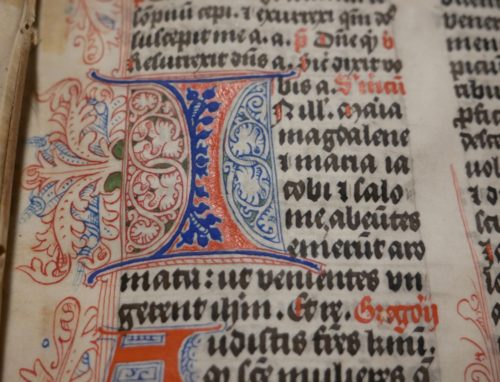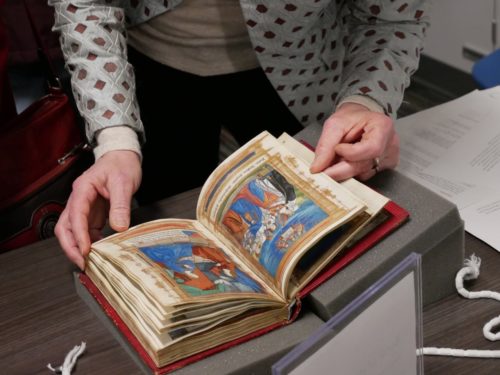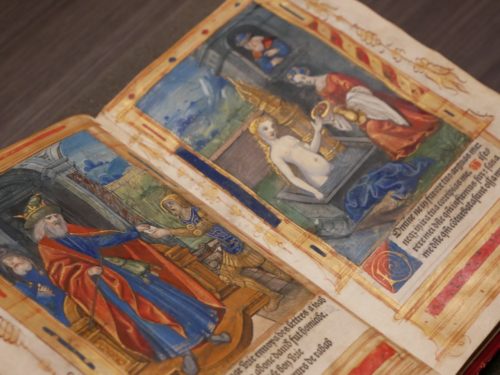 While books dating back to the late Middle Ages are often locked behind glass in museums and archives, the University of Guelph’s McLaughlin Library has borrowed nine medieval manuscripts you can touch and flip through as you would any other book.
While books dating back to the late Middle Ages are often locked behind glass in museums and archives, the University of Guelph’s McLaughlin Library has borrowed nine medieval manuscripts you can touch and flip through as you would any other book.
Ranging from a thirteenth-century English Bible and a fifteenth-century German Office of the Dead to a copy of Juvenal’s Satires made in mid-1400s Italy, these literary and artistic works will provide experiential learning for several hundred U of G students this semester.
Other visitors from seniors to schoolchildren will also get hands-on access to the medieval European manuscripts to peruse their parchment leaves and pore over their hand-rendered Latin texts and illustrations.
“That’s what so unique about this – touching and turning the pages and getting a closeup look,” said history professor Susannah Ferreira, whose students will be working with the manuscripts.
CTV Kitchener featured a three-part report on the manuscripts. Here are Part 1, Part 2, and Part 3.
U of G becomes only the second institution in Canada to borrow part of the collection of Les Enluminures – a Chicago rare book dealer – under the company’s manuscripts in the curriculum program.
A team of library staff and College of Arts faculty members received library funding for the loan.
 The loaned manuscripts will form an exhibit curated by graduate students in history to be held this semester in the library’s Archival and Special Collections. Students will present papers based on the collection during a planned research colloquium this semester, and the manuscripts will be featured during a conference of Canadian medieval art historians at U of G in March.
The loaned manuscripts will form an exhibit curated by graduate students in history to be held this semester in the library’s Archival and Special Collections. Students will present papers based on the collection during a planned research colloquium this semester, and the manuscripts will be featured during a conference of Canadian medieval art historians at U of G in March.
Among Ferreira’s favourite works in the collection is a Book of Hours (containing prayers and psalms recited daily by its owner) made in Paris in 1526 that combines printed Latin and French text with traditional, hand-drawn illustrations.
“It shows the transition of culture from manuscripts to print. There’s a kind of electricity when you connect with something that old.”
She’s teaching four classes this semester from early modern Europe to workplace learning whose combined 50 students are working with the collection. Students in one senior course will create a digital exhibit and catalogue based on the works.
Other students in her first-year seminar on the cultural significance of medieval manuscripts are creating an outreach program to promote the collection to local seniors’ groups and schools.
 Ferreira said working with the collection can help prepare students for careers in archives and libraries or for graduate studies in history or art history.
Ferreira said working with the collection can help prepare students for careers in archives and libraries or for graduate studies in history or art history.
Her co-instructor in that first-year course is Melissa McAfee, special collections librarian at U of G. McAfee said the hand-rendered text and illustrations in medieval manuscripts offer an antidote for our “hectic, modern-day world. They get people to stop, reflect and think. It gives people permission to do that.”
The student colloquium called “From Parchment to Pixels” will take place March 12 with a keynote talk by William Noel, a manuscript expert and special collections librarian at Princeton University. Co-sponsored by the THINC Lab (The Humanities Interdisciplinary Collaboration Lab), the event will also launch an exhibit created by U of G students in the library’s archival gallery from March 12 to May 12.
The Canadian Conference of Medieval Art Historians will take place on campus March 13-14.
For information, contact Ext. 58927 or mamcafee@uoguelph.ca.